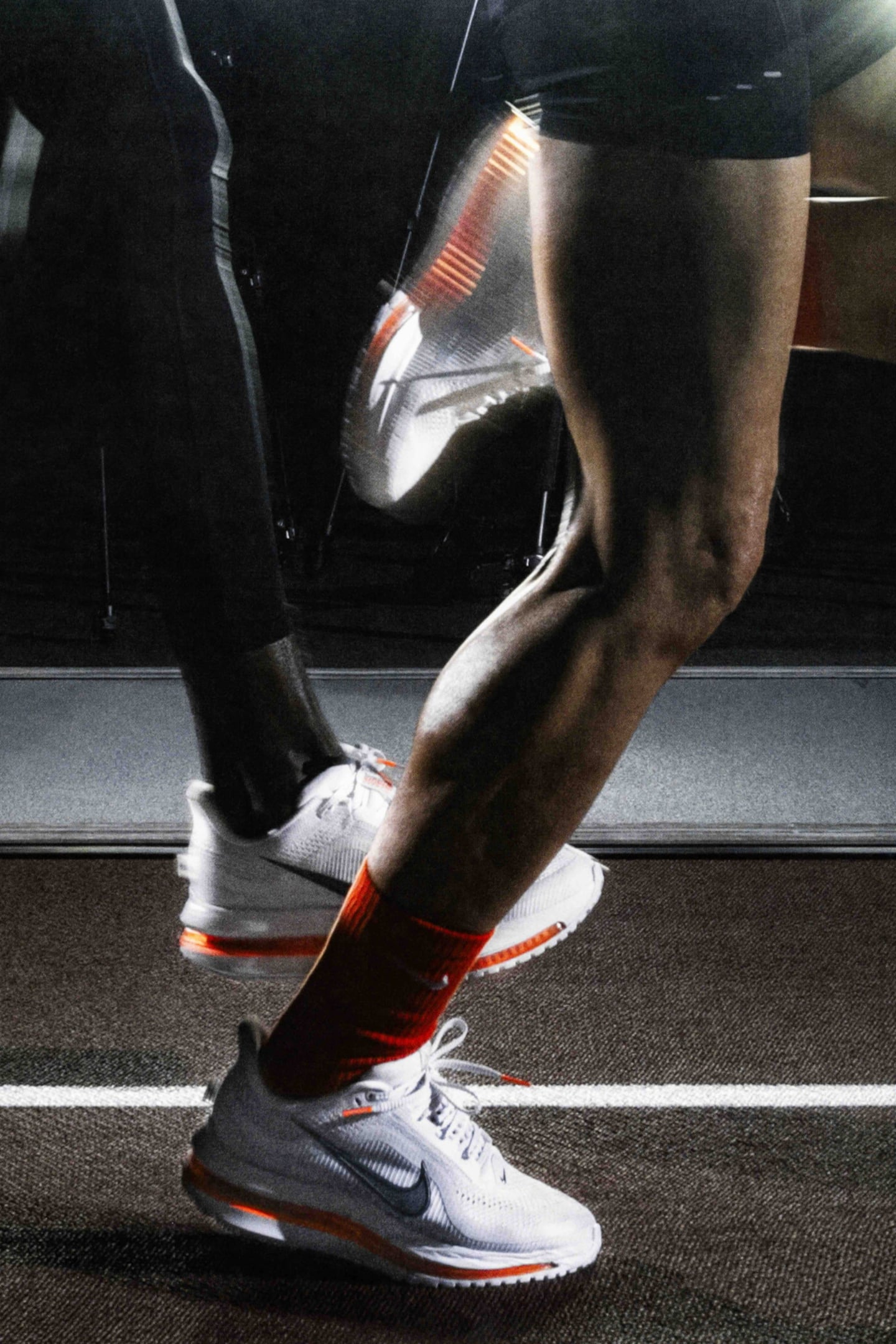Agenda-setting intelligence, analysis and advice for the global fashion community.
On January 30, Nike released a running shoe it says offers the “most energy return” to date in its decades-old Pegasus line, with two types of proprietary foam and its Air cushioning “sculpted” into a newly curved shape inspired by the carbon plates used in the super shoes worn by elite marathoners.
Nike, at least, is convinced the Pegasus Premium pushes the boundaries for what a running shoe can be. The question is, will shoppers care?
Innovations that promise athletes better performance are among the most powerful tools sneaker brands have at their disposal. They provide a way to stand out in a crowded marketplace and persuade shoppers their product is the best money can buy. When brands get it right, the rewards can be immense. Upstarts such as On and Hoka have shaken up the market with fresh technologies that have captured the attention and spending of runners looking for cutting-edge products to help them perform their best.
The costs can be just as great when brands fall behind. Analysts and experts have attributed Nike’s ongoing slump — its worst in decades — in large part to a lack of innovation and overreliance on retro basketball styles.
ADVERTISEMENT
But innovating isn’t easy. It can be expensive and demanding, requiring not only creativity and ingenuity but also months or years of testing and refinement. And with so many brands peddling new technologies, there’s no guarantee shoppers will understand what makes one product better than another. Standing out is particularly challenging with casual wearers who make up the majority of sales, even for specialised sneakers like running shoes. (A Circana survey of US consumers last year found 57 percent wore the footwear for work, school and other activities unrelated to running).
It’s entirely possible, then, that a brand can have the most patents, the biggest research budget and the highest-performing sneaker on the market, and still fail to capture consumers’ imaginations. Innovation increasingly means products that can do it all, striking a magical balance of utility and style that brands have to communicate to a range of different consumers with different needs and interests through the product itself and the storytelling around it.
“It’s a strange combination between logic and emotion, mind and soul, design and technology,” said Massimo Giunco, a brand consultant and former Nike marketing veteran.
Structural Innovation
Giunco, who left Nike in 2022 as a senior brand director and made waves last July with a widely read LinkedIn post calling out Nike’s missteps, said in his role overseeing 600 stores across Europe much of what he did was try to highlight Nike innovation to communicate its superiority as a brand. The windows, the store entry, the product displays and the mannequins were all coordinated to promote whatever new technology Nike was pushing.
“The most important piece of innovation for Nike was the structural innovation, where you have one technical element that was able to improve performance, and we used [it] in all the categories Nike was playing [in],” he said. “This is the biggest growth driver that Nike had.”
Nike helped pioneer the playbook with ideas like its Air cushioning, which it introduced in running shoes in the late 1970s and later incorporated into other categories, notably basketball through products like the Air Force 1 and the Air Jordan line. Today, it’s a common strategy across sneaker brands. The foundation of On’s business, for instance, remains the CloudTec cushioning — basically a series of segmented tubes — that can be seen across its shoes.
The importance sneaker brands place on innovation is evident in their patent filings, a category in which Nike is the undisputed leader, according to data compiled by intellectual property law firm Mathys & Squire. Adam Gilbertson, managing associate at the firm, said big companies may also file patents as a defensive tactic to prevent competitors from using the ideas. The strategy is generally only available to big players with deep pockets, since the legal costs can be high.
In a statement, Nike said its ideas are its competitive advantage. “Nobody invests more in athletes who inspire those ideas, backed by a global network of sport scientists, designers and manufacturing experts who translate them into amazing products for everyone,” it said. Nike added that while it still has work to do rounding out its product portfolio, it’s encouraged by its momentum in sports like running.
ADVERTISEMENT
While the structural innovations Giunco referred to are generally rooted in athletic performance, they may need to do more than help someone run faster or jump higher to reach the widest range of shoppers.
“There are three reasons [customers] come in looking for shoes: It’s usually to find a solution to increase comfort, find a solution that’s going to relieve pain or find a solution that’s going to increase performance,” said Victor Ornelas, senior director of vendor management at the running specialty chain Fleet Feet — with priority in that order.
Most customers don’t come into the company’s stores knowing about a specific new innovation a brand has released. They’re often in search of guidance about the myriad options available and may have heard of a shoe through word of mouth.
Ornelas said that other big points of attraction for shoppers walking into a store are colour and “what looks a little disruptive.” When Hoka’s shoes with their stacked — and now widely imitated — midsoles hit the market, for example, they were conversation starters that prompted customers to want to know more about the brand.
Form Is Function
While the way a new innovation looks might not be the primary concern designers of performance products have in mind, appearance is always a consideration, and the design itself serves as an important form of communication.
“How a product will be adopted, it’s somewhat out of our hands, although we can have an influence on it,” said Alexander Taylor, Adidas’ senior vice president of innovation, design and concepts. “If something looks comfortable, then it’s easier to adopt. If something looks like it’s fast, then it’s easier to adopt for a particular purpose, so that’s very much built into the way in which we work.”
Taylor said when his team gets a design brief, it will usually centre on a specific performance goal, like helping one of Adidas’ sponsored stars break a running record. It’s up to the other teams at the brand to sell it to shoppers. But he also emphasised that, as designers, they strive to create beautiful objects that will resonate with customers.
As far as connecting with mainstream consumers, an innovation’s look can matter almost as much as how well it performs. As sneakers have become the everyday footwear of legions of consumers, their uses have expanded, meaning even shoes intended for sports frequently double as fashion. Running itself is treated like a lifestyle as much as an activity these days.
ADVERTISEMENT
“It’s definitely an art and a science,” Beth Goldstein, executive director and industry analyst covering footwear and accessories at Circana, said of creating new performance products. “You never know what’s going to catch on as a fashion trend.”
Given the high costs of running shoes these days, shoppers also want to be able to integrate them into their everyday lives — and outfits — to get as much use and value out of them as possible. Top sneakers are routinely priced at $150 and up. Nike’s Pegasus Premium comes in at $210. In fact, Goldstein noted that performance running was one of the fastest-growing segments of the sneaker market in 2024, up 6 percent compared to the previous year, and that increase was driven by rising prices, not an increase in units sold. Innovation becomes a selling point that justifies the cost.
“There’s this trading up towards the Hokas and Ons, and those are at higher price points. Brooks in some cases as well,” she said. “That’s where I think the idea of innovation for the most part comes into play.”
Performance technologies can benefit casual wearers, too. The same idea that produces more bounce or stability in a running sneaker can also make it more comfortable or pain-free for everyday use.
Companies have also learned that innovation helps cast a halo of prestige over the entire brand. During a 1992 interview, when asked if Nike was a technology company or a marketing company, co-founder Phil Knight replied, “We’ve come around to saying that Nike is a marketing-oriented company, and the product is our most important marketing tool.”





